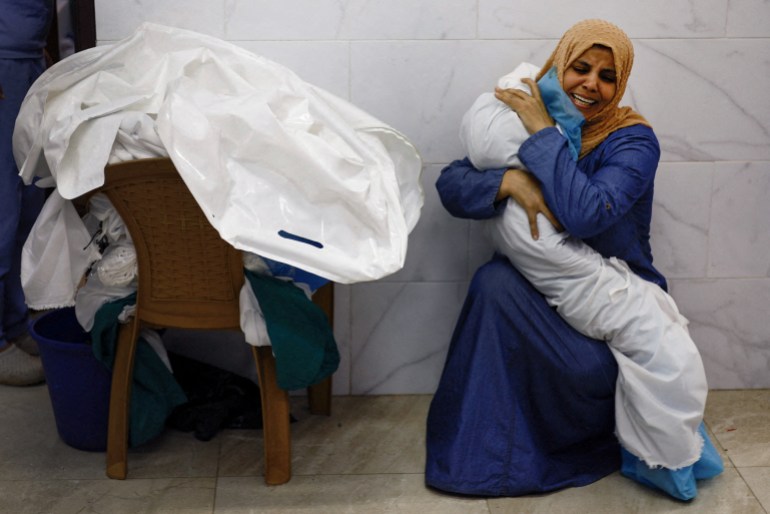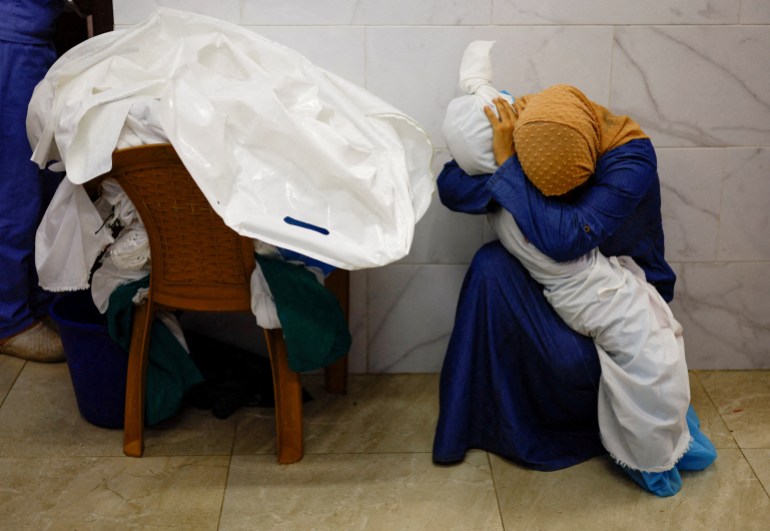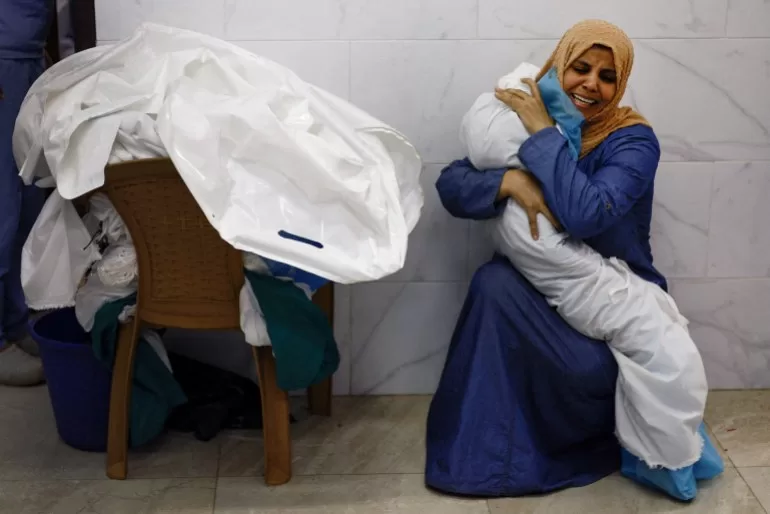The only visible identifier in this photograph is Abu Maamar’s left hand. Though she has not even reached middle age, the skin on her fingers and the back of her hand is already a little rough. I imagine that her hands have scrubbed pots, kneaded daily bread, come too close to the walls of a scorching hot oven. It is a hand that has been singed by hardship and history. It enfolds her niece’s face, fingers splayed and searching, as if attempting to read her beloved’s features in the dark.
The photograph, taken by Reuters photographer Mohammed Salem on October 17, 2023, was recently awarded the prestigious World Press Photo of the Year by World Press Photo Foundation (WPP), an independent, non-profit organisation based in Amsterdam, Netherlands. The jury noted that Salem’s 2024 winning image – which was given the title, “A Palestinian Woman Embraces the Body of Her Niece” – was “composed with care and respect, offering at once a metaphorical and literal glimpse into unimaginable loss”.
Salem took the photograph at Nasser Hospital in Khan Younis. There, he found families had gathered to search for the bodies of loved ones killed in Israeli bombardment on civilian homes, as families have done since Israel began its genocidal assault on Gaza on October 7.
Salem’s photograph emerges from a vast number of images and thousands of minutes of video that Palestinians have been disseminating through social media platforms over the past six months, documenting their own genocide. It has become one of the most well-recognised, much-shared images of the genocide – one of those “iconic” images of war, surfacing again and again on newsreels and social media posts.
Why did this particular photograph of a mourning woman and lifeless child captivate audiences around the world? What drew the members of WPP’s jury to this photograph – rather than other photographs that Salem took of the same woman mourning the deceased child?
Cropping out context
Prestigious awards for photography and the juries that determine what is worthy of exceptional praise tend to favour images that hint at layered, if limited in what layers are permitted, narratives, allowing viewers to engage with just enough complexity. Juries often reward images that provide easy entry for those perceived to be the dominant group of viewers.
In another photograph that Salem took of Abu Maamar, in which her face is visible, her mouth is open in a naked expression of distress. This image gives her an individual identity; her grief is a screaming, uncontainable horror.
A plastic chair can be seen to the left of her, white body bags piled up on it. The leg and shoe of a man wearing all blue – a medical professional, perhaps – stands to the far side, the unidentified witness to her grief, perhaps to thousands of such griefs.

The body bags would have alluded to genocide. Audiences would not be able to reduce the narrative to a singular loss, to an isolated, ahistorical moment of Orientalised grieving.
But in this “winning” frame, Abu Maamar’s face cannot be seen, her personhood is subsumed, passive, and accepting of divine dictates. Her emotions would be too powerful, her grief too inelegant in its lack of containment, should they be seen by the public.
As long as the suffering is tidy, and coded through Western art historical references to innumerable paintings and sculpture of Mary grieving the death of her son, Jesus, viewers may project a range of narratives onto the woman. This way of framing her does not provoke fear of an other’s rage – it is not an unwordable, uncontained, roaring suffering. Rather, it is a safe, consumable display of grief and suffering.
WPP’s selection for World Press Photo of the Year was cropped to remove any contextual material that surrounds Abu Maamar and her niece. The photograph is also cropped, in more metaphorical terms, of the conditions and history that led to this specific child’s death and this living relative’s unbearable suffering. The materiality of that history – and the millions displaced and starving under siege, the tens of thousands dead and the many under bombed buildings without even the dignity of being shrouded and buried – is strategically made absent.
Such cropping reinforces the reproduction of a particular type of liberal politics, and a specific methodology of framing “conflict” essential to liberal ways of grieving. It allows one to continue to insist on “both sides” of the argument, and situate oneself in a location where it is possible to mourn and – unconsciously, perhaps – celebrate one’s ability to feel sympathy, without having to truly recognise the genocidal horror playing out in real-time. To recognise it would mean that one would be forced to act.
Cropped images aid the continuation of cropped politics. This dynamic is especially evident in the power imbalance between an army supported by the US and equipped with billions worth of weaponry and armed groups without such support; “those without” are people that the geopolitical West regards as an “Oriental other”.
Demanding the elimination of context has been essential to Israel’s justification of genocide in Gaza. Excising the context – including any reference to 75 years of dispossession, occupation, imprisonment without trial, torture, daily brutality, and slow genocide – has, in turn, shaped the narrative.
That has been apparent in US media across print, TV and radio. Mainstream media outlets announce, repetitively, at the beginning or end of reports, that “Israel began its bombardment of [Gaza] in response to the attack by the militant group Hamas on October 7.” It is as though Israel’s violent exercise of power began on October 7, and only because of a provocation by a Palestinian party.
Gaza photographers as ‘Hamas sympathisers’
Asim Rafiqui, a photographer and photography scholar, told me in an interview, that one of the main reasons that this image – “out of a mountain of photographs” – was deemed worthy of an award, is that “winners” must silence far more than they reveal. A winner must be “a cleansed, commodified, social media appropriate image, evaluated and filtered for ‘sensitive content’ as we’ve become so accustomed to seeing.”
A photo editor with a prominent news agency who wishes to remain anonymous also reminded me that Israel’s foreign ministry used scare tactics to discredit Palestinian photojournalists as Hamas sympathisers and collaborators.
After Yousef Masoud, another Palestinian photojournalist based in Gaza, won an award in February, the spokesperson for the Consulate General of Israel in New York claimed, in a letter, that he had “links” to Hamas and had prior knowledge of the October 7 attack, which “mortally compromise[ed] the integrity of his reporting”.
Masoud was one of several photojournalists whose images of the attack were, according to Israeli claims, used by the AP, Reuters, The New York Times and CNN.
However, the photo editor told me this was a “cheap tactic by Israeli forces to delegitimise [the journalists’] work”; after all, “photojournalists went alongside the [Israeli military], using their cameras to produce ‘poetic’ black and white photographs in the aftermath of destruction.”
And photojournalists infamously embedded with the US army, as it invaded and occupied Afghanistan and Iraq, producing images that celebrated and legitimised the brutal actions of armies and contractors hired by participating states.
The photo editor also pointed out that when a photographer is a white European like Italian Massimo Berruti, who lived long term in Pakistan’s Swat valley, embedded with Lashkars – a civilian militia, not an army associated with a state – they are praised. But Gaza’s photojournalists who are just as daring and committed to producing documentary visuals are seen as “Hamas sympathisers”.
The pressure that Israel applied had immediate effect. Rafiqui states that wire services like the AP and Reuters, as well as other global news outlets that uphold and reproduce the power structures of the geopolitical West quickly made the decision to work only with those who have been incorporated by corporate media, “thereby garlanding authority and credibility” solely to themselves as dependable sources of news.
While “the visual archive was being produced in real-time by the people of Gaza, their witnessing was refused [by Western corporate media] … effectively erasing and discrediting all Gazans who are independently documenting what is happening to them,” Rafiqui said.
Awarding consumable images
To state what should be obvious: the visual narratives that make up what we imagine to be “the news” – supposedly impartial, balanced, and accurate – are created through processes that reflect existing power structures, which benefit from history being portrayed in favour of those in power.
Prestigious awards such as World Press Photo, which elevate certain images above others, instruct generations of photographers from around the world. Photographers, photo editors, and jurists of photography awards bring with them their moral views, ties to powerful people in the industry, and structures that support their ecosystem – other photo editors, photojournalists, donors, and ever-shrinking global media houses owned by a handful of powerful owners. Some may be consciously critical of the origins of their viewpoints; others not so much.

Awards are thus structured in ways that favour easily commodifiable images. “Winners” need to be consumed; and to be consumed easily, they must allow for metaphorical interpretations, so that a broad range of meanings may be thrown at the surface, and stick.
To be consumed easily, winners cannot include too much dangerous, difficult-to-digest context. That would only alienate audiences. Better to stick with a woman whose face and visceral, raging grief is contained within “safe” Orientalist tropes that only signal to many in the geopolitical West her supposed oppression under her own culture.
It is important to recognise that the reinforcement of well-known tropes of Orientalist ways of looking, seeing, and reading do not arise, in this case, from the photographer’s callousness or lack of embeddedness within the community that they are documenting.
Salem is from Gaza, and clearly working under horrific, dangerous conditions. There is no need to undermine his work. Some may criticise Salem for photographing a grieving woman at one of the most vulnerable moments in her life. Such photographs usually evidence vast imbalances in power. It brings about attendant questions about why anyone should have the right to photograph a person without their consent, if consent is even possible at such a moment.
Shielding one’s face is a sign that a person is attempting to maintain some privacy and agency, even as the camera intrudes. But in this case, she may not be “hiding” her face solely to shield herself from the camera in front of her; rather, it is one of many of the ways in which Abu Maamar arranges and rearranges herself in grief.
Salem’s response to the recognition by WPP is telling. According to Reuters Global Editor for Pictures and Video, Rickey Rogers, the photographer reportedly “received the news of his WPP award with humility, saying that this is not a photo to celebrate but that he appreciates its recognition and the opportunity to publish it to a wider audience.”
It is an arresting image. Mohammed Salem is more than deserving of the recognition that an award from WPP brings. But asking the question, “Why this photograph, among the millions of others?” reveals a far more uncomfortable set of truths about the ecosystem that rewards and elevates decontextualised, ahistorical images.
The views expressed in this article are the author’s own and do not necessarily reflect Al Jazeera’s editorial stance.
